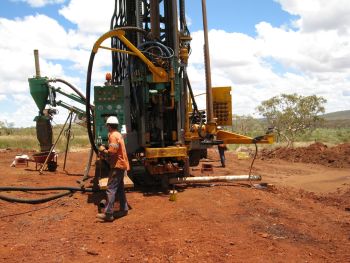Wash Borings: Difference between revisions
No edit summary |
No edit summary |
||
| (3 intermediate revisions by 3 users not shown) | |||
| Line 10: | Line 10: | ||
<!-- Add picture caption --> | <!-- Add picture caption --> | ||
|caption= Remote-Controlled Drill Rig | |caption= Remote-Controlled Drill Rig | ||
(Image Source: [https://ga.wikipedia.org/wiki/Acmhainn%C3%AD_neamhinathnuaite Wikipedia]) | |||
}} | }} | ||
| Line 15: | Line 16: | ||
"A wash boring is a means of rapidly advancing a hole by striking or rotating, cutting, or chopping tool and by jetting with water, which is pumped through the hollow [[drill]] rod and bit. This method usually requires the use of casing. Cuttings are removed from the hole by the water circulating upward between the drill rod and casing. The cutting tool is alternatively raised and dropped by the tightening and slackening of a line wrapped around a cathead. A tiller attached to the drill rod permits the rod and cutting tool to be rotated. The material brought to the surface in the circulating water is nonrepresentative of materials in place. Consequently, positive identification of particular strata is not possible when holes are advanced by the wash-boring method."<ref name="NEH_CH5">[[National Engineering Handbook: Chapter 5 - Engineering Geology Logging, Sampling, and Testing | National Engineering Handbook: Chapter 5 - Engineering Geology Logging, Sampling, and Testing, NRCS, 2012]]</ref> | "A wash boring is a means of rapidly advancing a hole by striking or rotating, cutting, or chopping tool and by jetting with water, which is pumped through the hollow [[drill]] rod and bit. This method usually requires the use of casing. Cuttings are removed from the hole by the water circulating upward between the drill rod and casing. The cutting tool is alternatively raised and dropped by the tightening and slackening of a line wrapped around a cathead. A tiller attached to the drill rod permits the rod and cutting tool to be rotated. The material brought to the surface in the circulating water is nonrepresentative of materials in place. Consequently, positive identification of particular strata is not possible when holes are advanced by the wash-boring method."<ref name="NEH_CH5">[[National Engineering Handbook: Chapter 5 - Engineering Geology Logging, Sampling, and Testing | National Engineering Handbook: Chapter 5 - Engineering Geology Logging, Sampling, and Testing, NRCS, 2012]]</ref> | ||
== | ==<noautolinks>Best Practices Resources</noautolinks>== | ||
{{Document Icon}} [[National Engineering Handbook: Chapter 5 - Engineering Geology Logging, Sampling, and Testing | National Engineering Handbook: Chapter 5 - Engineering Geology Logging, Sampling, and Testing | {{Document Icon}} [[National Engineering Handbook: Chapter 5 - Engineering Geology Logging, Sampling, and Testing | National Engineering Handbook: Chapter 5 - Engineering Geology Logging, Sampling, and Testing, NRCS]] | ||
<!-- In the location of an in text citation, simply enclose the citation as follows: <ref> citation </ref>. Citations will automatically populate. Learn more at https://www.mediawiki.org/wiki/Help:Cite. --> | <!-- In the location of an in text citation, simply enclose the citation as follows: <ref> citation </ref>. Citations will automatically populate. Learn more at https://www.mediawiki.org/wiki/Help:Cite. --> | ||
Latest revision as of 20:28, 21 July 2023

|
| Remote-Controlled Drill Rig
(Image Source: Wikipedia) |
"A wash boring is a means of rapidly advancing a hole by striking or rotating, cutting, or chopping tool and by jetting with water, which is pumped through the hollow drill rod and bit. This method usually requires the use of casing. Cuttings are removed from the hole by the water circulating upward between the drill rod and casing. The cutting tool is alternatively raised and dropped by the tightening and slackening of a line wrapped around a cathead. A tiller attached to the drill rod permits the rod and cutting tool to be rotated. The material brought to the surface in the circulating water is nonrepresentative of materials in place. Consequently, positive identification of particular strata is not possible when holes are advanced by the wash-boring method."[1]
Best Practices Resources
![]() National Engineering Handbook: Chapter 5 - Engineering Geology Logging, Sampling, and Testing, NRCS
National Engineering Handbook: Chapter 5 - Engineering Geology Logging, Sampling, and Testing, NRCS
Citations:
Revision ID: 7431
Revision Date: 07/21/2023
